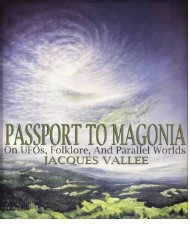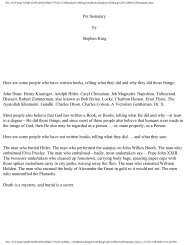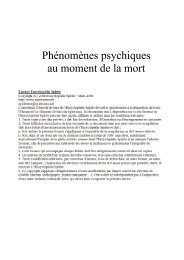extraordinary%20encounters
extraordinary%20encounters
extraordinary%20encounters
Create successful ePaper yourself
Turn your PDF publications into a flip-book with our unique Google optimized e-Paper software.
down an old logging trail that took him<br />
deeper into the forest. As he entered a<br />
clearing, he saw a hovering UFO that, he later<br />
related to a local newspaper reporter, “appeared<br />
to be made of a glowing, sun-colored<br />
substance similar to plastic and was shaped<br />
like two saucers fused together. I judged it was<br />
about eighty feet horizontally and thirty-two<br />
vertically” (“Centralian Tells,” 1950). Equally<br />
peculiar was the sight of tanned, fine-featured,<br />
naked children playing on steps that led from<br />
the saucer to the ground.<br />
Excited, Thompson approached the craft,<br />
feeling a mild heat emanating from it—the<br />
cause, he would learn subsequently, of its occupants’<br />
tanned skins. As he came nearer, his<br />
presence brought the adults—beautiful and<br />
nude, with dark blond hair—to the door.<br />
They seemed frightened of him. He told them<br />
he meant no harm, and they relaxed. After<br />
asking him in clumsy English to remove his<br />
shoes and socks, they invited him inside,<br />
where he spent the next forty hours.<br />
He learned that they we re from Ve n u s .<br />
The ship was also their home. It carried ten<br />
men and ten women as well as twe n t y - five<br />
c h i l d ren between six and fifteen years old. Int<br />
e rv i ewed a few days later by private pilot and<br />
we l l - k n own UFO witness Kenneth Arnold,<br />
Thompson said the Venusians we re friendly<br />
and cheerful but curiously naïve. He comp<br />
a red them to animals, meaning that instinct<br />
rather than intellect governs their activities.<br />
They knew nothing of the technology that<br />
p owe red their ship; they knew which buttons<br />
to push and levers to pull to get where they<br />
wanted to go, and that was it. They had no<br />
sense of time and no curiosity, and because of<br />
their eating habits—they we re ve g e t a r i a n s<br />
and stayed away from cooked foods—they<br />
n e ver got sick and lived long lives. Their ve getables<br />
we re like those found on Earth, and<br />
Thompson ate some while on the “s p a c e s h i p”<br />
(the word the Venusians used for their craft).<br />
He pronounced the food “just gre a t . ”<br />
Venusians fear earthlings because human<br />
aircraft had shot down some of their spaceships.<br />
Earth is considered a bad planet, but<br />
Thompson’s Venusians 243<br />
Mars is even worse. There are twelve inhabited<br />
planets in the solar system. Each resident<br />
is born under the sign of the planet on which<br />
he or she is born, except for Earth, whose<br />
problems stem from the fact that each person<br />
is born under a different sign. Venusians and<br />
earthlings long ago were very close, sharing<br />
“the first religion ever known,” but the people<br />
of Earth eventually became corrupt, and a<br />
curse was cast upon their planet. Venusians<br />
and other space people are now reincarnating<br />
on Earth; their goal is to reform the earthlings<br />
and prepare them for Christ’s Second Coming<br />
in A.D. 10,000.<br />
After sleeping overnight in a chair in one of<br />
the ship’s bedrooms, Thompson asked for permission<br />
to go home and pick up a camera.<br />
They did not know what a camera was. When<br />
he explained, they said he could go but asked<br />
him not to bring anyone else along. The photographic<br />
experiment came to nil. It was “just<br />
like trying to take a picture of the sun,” he<br />
told Arnold. “It has a glow to it. That film was<br />
just blank. I wanted to get some of them right<br />
onto the ground to take some pictures of<br />
them, but they wouldn’t come out” (Clark,<br />
1981).<br />
The Venusians left on Ma rch 30, cautioning<br />
Thompson to keep certain information to<br />
h i m s e l f. If he ever saw them again, no one eve r<br />
k n ew. For many years his story was little<br />
k n own, with a brief newspaper account the<br />
only re c o rd of it. In 1980, Arnold gave a tape<br />
of his early April 1950 interv i ew with T h o m pson<br />
to Fa t e magazine, and an article largely<br />
based on it appeared in the Ja n u a ry 1981<br />
issue. Arnold re m a rked on T h o m p s o n’s ignorance<br />
and lack of imagination, and he was<br />
convinced that Thompson believed his story,<br />
its outlandish, even absurd, qualities notwithstanding.<br />
Arnold speculated that he had undergone<br />
some sort of “p s yc h i c” experience.<br />
See Also: Adamski, George; Contactees; Hopkins’s<br />
Martians<br />
Further Reading<br />
Arnold, Kenneth, 1980. “How It All Began.” In<br />
Curtis G. Fuller, ed. Proceedings of the First Inter -<br />
national UFO Congress, 17–29. New York:<br />
Warner Books.





